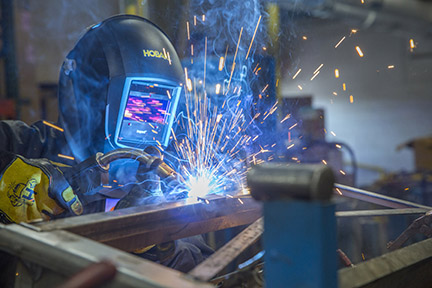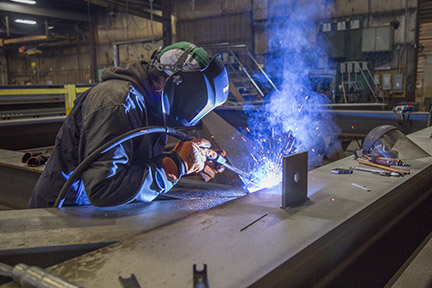Welding Shielding Gas and Weld Performance: Here’s What You Need to Know
Gaining consistent performance and quality in the welding operation is the result of many factors. From the skill of the welding operator to the available equipment and filler metal, each plays an integral role. At the end of production, the key is for the finished weld to withstand the service conditions it counters without risk of corrosion, cracking or other detrimental effects.
Along with the formulation of the filler metal being used, shielding gas directly impacts welding performance — for example, how smoothly the wire welds, its spatter levels and its arc qualities. Shielding gas can also affect the amount of weld fume generated and can alter the mechanical properties of the completed weld.
Knowing how to select the appropriate shielding gas for an application helps welding operators achieve the desired welding performance and also minimize rework caused by poor weld quality.

The basics of shielding gas
As a requirement of welding with a solid, gas-shielded flux-cored or metal-cored wire, the primary purpose of shielding gas is to protect the molten weld pool against elements in the atmosphere, such as nitrogen and hydrogen. If those external elements enter the weld pool, it can create a host of problems, including (but not limited to) porosity and cracking.
Shielding gas can affect the transfer of the filler metal from the arc to the weld joint, which contributes to the efficiency of the welding process and the quality of the weld by determining weld penetration profiles.
Carbon dioxide, argon, helium and oxygen are the most common shielding gases used in the welding process, and each impacts welding performance differently based on its individual characteristics.
When deciding which shielding gas to use, it’s important not only to take into account the desired welding properties, but to also consider cost and available labor for weld preparation and other non-welding activities.

What to know about carbon dioxide and argon
Carbon dioxide (CO2) gas is the least expensive reactive gas and the most often used in welding. It is also the only shielding gas that can be used without adding an inert gas. Since using 100 percent CO2 shielding gas provides broad, deep joint penetration, it is ideal for welding thick material. The downside of straight CO2 is that it tends to create a less stable arc and more spatter than when it is mixed with other gases such as argon. Additional spatter, as any operator knows, requires post-weld cleaning that leads to unwanted downtime.
Using 100 percent argon is common when welding aluminum, magnesium or titanium because it creates a stable arc, provides a consistent weld quality and appearance, and gives operators good weld pool control. It also produces a narrow penetration profile, which makes it ideal for fillet and butt welds. Since argon produces less spatter, it can also help minimize the downtime associated with post-weld cleanup.
Many operators add argon to a CO2 mixture when welding materials like carbon steel because it generates high productivity rates and helps create visually appealing welds. These mixtures typically consist of 75 to 95 percent argon and 25 to 5 percent CO2.
There are many factors related to the strength and ductility of a weld that should be considered when using argon mixtures versus straight CO2 shielding gas.Shielding gas with higher argon content produces welds with higher tensile and yield strengths but lower ductility, while higher CO2 content in a shielding gas mixture improves ductility and crack resistance but lowers the tensile and yield strengths.Some applications may not require higher argon content because the higher strength it delivers is unnecessary and would needlessly make the weld more susceptible to cracking. However, other welds may call for this higher content because they might otherwise fail to meet minimum strength standards.
High heat input has a similar effect on the mechanical properties of the weld as CO2, in that it reduces strength and increase ductility. Conversely lower heat inputs and high argon content gas will do the opposite, increasing strength and reducing ductility. For this reason, heat and shielding gas balance can often be used to compound or offset these effects. For instance, a welding operator may choose to use a higher argon level in an application where high heat input has caused a decrease in the strength of the weld. Or if low heat input has adversely affected the ductility of the weld, straight CO2 shielding gas can minimize that effect.
Additional shielding gases
Helium is typically used for welding non-ferrous metals. It is also used when welding stainless steels in a tri-mix formula of argon and CO2. Helium creates a hot arc, which helps increase travel speeds and productivity rates. It also produces a wide, deep penetration profile, which makes it ideal for welding thick materials. Helium is often used in ratios of 25 to 75 percent helium with an appropriate balance of argon. By adjusting these ratios, welders can change weld penetration, bead profile and travel speeds. Since helium is more expensive than other gases and requires a higher flow rate than argon because it is so light, operators should carefully weigh the value of the increased productivity it provides against its higher cost.
Oxygen is a reactive gas that is usually used in ratios of 9 percent or less. The addition of oxygen to an argon mixture helps improve weld pool fluidity, weld penetration and arc stability — especially when welding carbon, low alloy and stainless steels. Since oxygen causes oxidation of the weld metal, in most cases it should not be used to weld aluminum, magnesium, copper or other exotic metals.
Always follow the filler metal manufacturer’s recommendations for the type and amounts of shielding gas that should be used for a given wire. Similar to other factors in the welding process, selecting the right shielding gas is vital to gaining good weld quality and minimizing unnecessary downtime. It can also affect the mechanical properties of the weld and ensure that the proper strength and ductility requirements are met.



